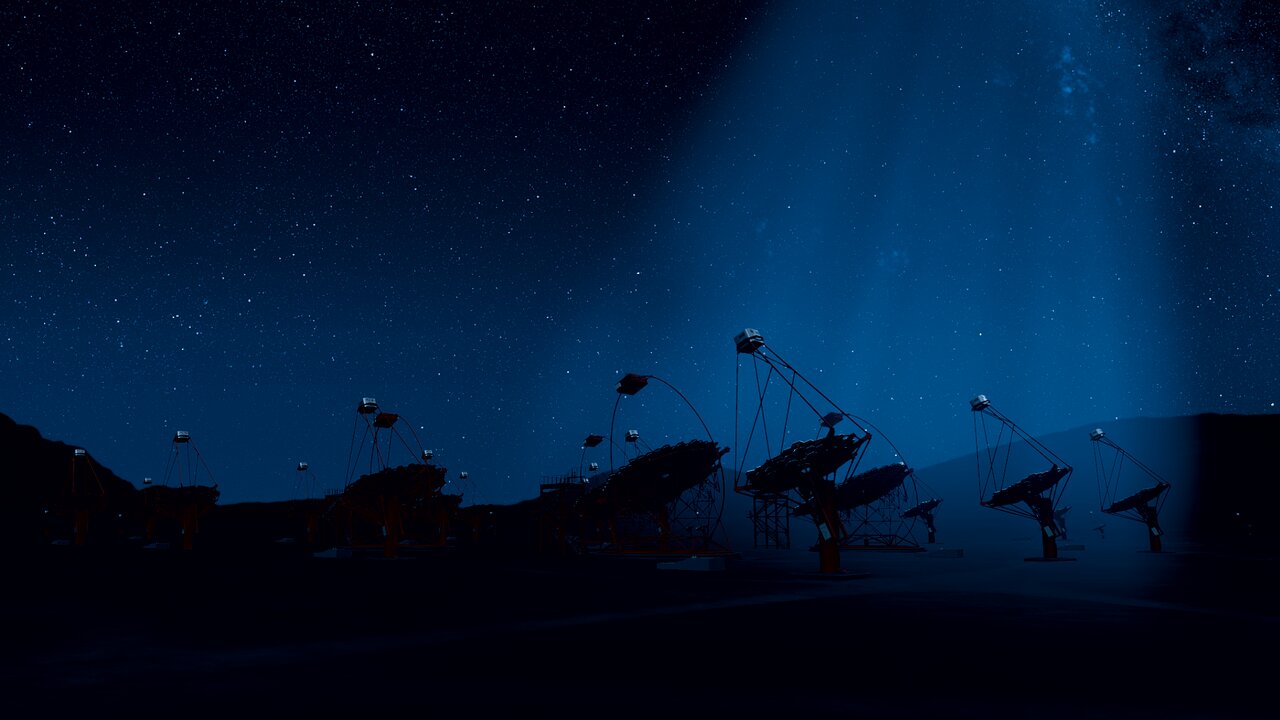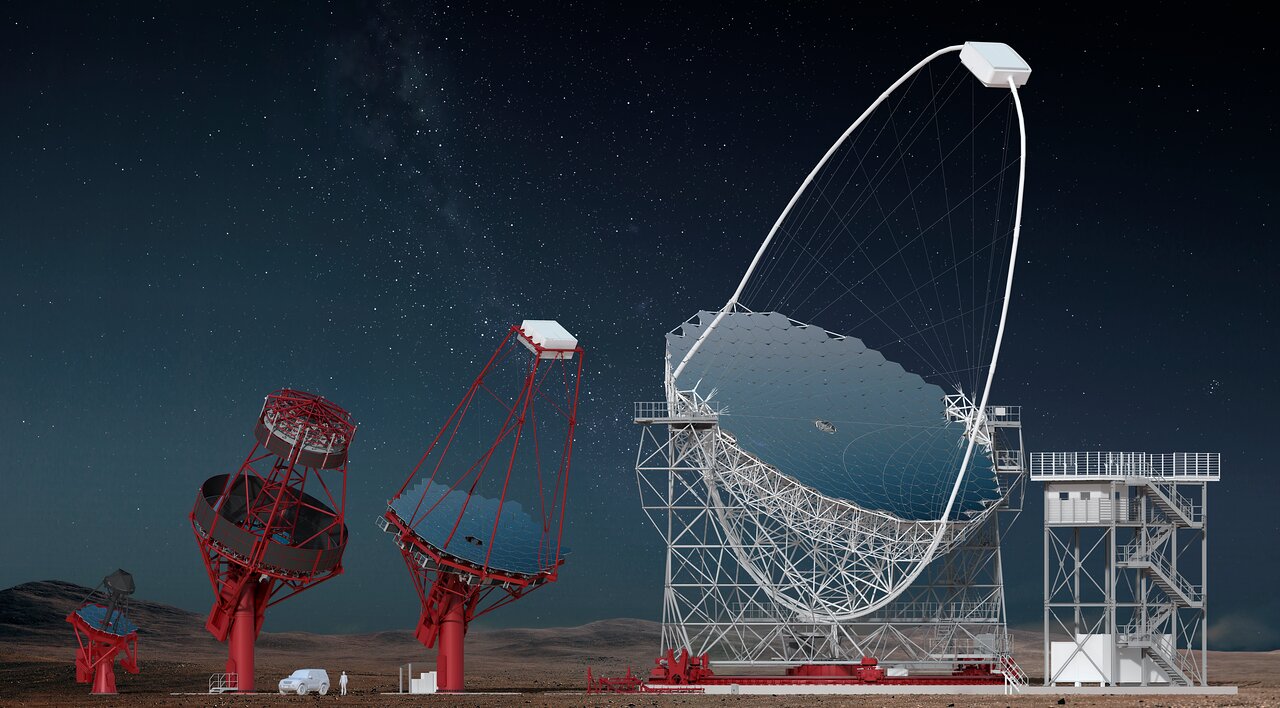
Exploring the Universe at the Highest Energies
The Cherenkov Telescope Array Observatory
- What are gamma rays
- Why astronomers are interested in them
- How the Cherenkov Telescope Array Observatory will detect them
Deep in the Atacama Desert in Chile, at ESO’s Paranal Observatory, a new facility is set to be built: the Cherenkov Telescope Array Observatory. It will detect signs of some of the most violent processes in the Universe, probe extreme environments such as those around black holes, and perhaps even shed light on dark matter through observations of very high-energy light — gamma rays.
“It’s the driest desert on Earth. There are no plants or trees. It’s just mountains, valleys, rocks, and sand. It’s pure form, I like it very much,” says Wolfgang Wild, the project manager of the Cherenkov Telescope Array Observatory (CTAO). This is an extreme place to build and work –– even the flags marking the position of the CTAO’s future telescopes have been disintegrated by the Sun’s intense radiation! But what will the CTAO observe, and why is it being built there?

Gamma rays — what are they?
We can learn a great deal about the world around us by looking with our eyes, but they tell us far from the whole story. Light comes in a wide range of colours or wavelengths across the electromagnetic spectrum: the longer the wavelength, the less energetic light is. Visible light sits in the middle of this spectrum, and gamma rays are at the high-energy extreme.
Paolo Padovani, an ESO astronomer who studies the central black holes in galaxies — some of which expel powerful jets and are very strong gamma-ray sources — explains that “our eyes can detect light with energy around two to three electronvolts [a small unit of energy]. Gamma rays start around a gigaelectronvolt –– that's a billion times higher. And the CTAO will detect up to 300 teraelectronvolts. That's more than 100 000 000 000 000 times the energy of light we can see with our eyes.”

High-energy gamma rays are produced in some of the most extreme environments in the Universe such as supernova explosions and black holes swallowing matter around them. Detecting gamma rays allows us to probe these events and learn more about them. The CTAO will do just that, and it may also detect signs of dark matter particles annihilating each other, or deviations from Einstein’s theory of special relativity.
“The CTAO will study physical processes related to explosive phenomena, very energetic sources, environments where you don’t want to be,” says Paolo. “This isn’t day-to-day physics, these are extreme physical phenomena which are impossible to study without gamma rays.”
However, high-energy gamma rays are incredibly hard to come by, as the extreme events producing them are very rare compared to the stars and galaxies that cover our night sky and that predominantly emit lower energy visible light. For example, the European Space Agency’s Gaia space telescope, which detects visible light, has in less than a decade observed close to two billion objects. But, at the time of writing, only 272 sources of light with energies above one teraelectronvolt have been found. There are undoubtedly many, many more out there in the vastness of space, but detecting them has always been problematic.
How do we detect gamma rays?
The Earth’s atmosphere acts as a protective blanket from large portions of the electromagnetic spectrum, as illustrated by the image below. Gamma rays are completely blocked by our atmosphere, which is vital for life on Earth, but this naturally causes a bit of a problem when trying to detect gamma rays from the ground.
Gamma-ray astronomy began in the 1960s, first by launching special detectors on balloons high up in the atmosphere, and then with increasingly complex satellites, leading to space telescopes like ESA’s INTEGRAL or NASA’s Fermi. However, space telescopes are limited by their inability to be repaired or upgraded, for obvious reasons, as well as by their size, as everything has to fit into a rocket.
But how can we detect gamma rays from the ground? When gamma rays hit the atmosphere they produce particles that travel faster than the speed of light in air. Just to clarify in case this sounds impossible: light travels about 0.03% slower in our atmosphere than in the vacuum of space. The showering particles fall to Earth faster than this reduced light speed, but still slower than the speed of light in a vacuum — rest assured, the fundamental speed limit of physics has not been broken!
When a particle travels faster than light in the atmosphere it emits a faint blue flash known as Cherenkov radiation; this is similar to the sonic boom from a plane flying faster than the speed of sound. As you may have guessed, it is from this Cherenkov radiation that the CTAO takes its name. “So a gamma-ray photon, which is blocked, thank God, by the atmosphere, gets showered down to Earth and becomes an optical photon,” summarises Paolo. “And for this reason, you could consider the atmosphere as part of the telescope’s detector,” adds Lieselotte Jochum, ESO Coordinator for the CTAO.
This pool of Cherenkov light is incredibly faint by the time it reaches the Earth’s surface — there are only a few photons per square metre — and very short-lived — it only lasts for a few nanoseconds. Detecting this ephemeral light is thus radically different from how other telescopes collect billions of photons, sometimes for hours on end. The CTAO will therefore be very different from its neighbours at ESO’s Paranal Observatory in order to observe these capricious Cherenkov flashes.

The Cherenkov Telescope Array Observatory
“The CTAO is a global project with contributions from countries around the world and from ESO,” says Nikolaj Gube, ESO legal advisor and delegate for ESO in the CTAO Council. “The CTAO scientific community already includes around 1500 scientists from more than 150 institutes distributed over 25 countries; every continent (excluding Antarctica) is represented.”
The CTAO will operate from two sites: CTAO-North on the island of La Palma, Spain, and CTAO-South hosted by ESO at our Paranal Observatory in Chile. This way the CTAO can get a full view of both the northern and southern hemispheres of the night sky.
While other Cherenkov facilities already exist, the CTAO is different in the way it’s operated and the technology it packs. First, the CTAO will be the first gamma-ray observatory open to the entire scientific community, with researchers being awarded observing time through a competitive selection process. The data and analysis software will be available worldwide (after a proprietary period), which is new for any ground-based gamma-ray facility. “The CTAO has strengthened the links between the astrophysics and particle physics communities,” explains Nikolaj, and engaging this wider group of scientists will therefore increase the scientific output of the CTAO.
Technology-wise, the CTAO will build on the experience from previous ground-based gamma-ray telescopes, with significant improvements. “In a nutshell, it will be bigger, better, higher, wider — everything”, says Lieselotte. Previous Cherenkov facilities like H.E.S.S., MAGIC and VERITAS had at most five telescopes, but the CTAO will have 51 at the Paranal site.
The telescopes will come in three different sizes with diameters of 4, 12, and 23 metres to capture an incredibly wide range of gamma ray energies — from 20 gigaelectronvolts up to 300 teraelectronvolts. The lower energy gamma rays are more common but produce fainter pools of Cherenkov light; for this a small number of the 23-metre Large-Sized Telescopes is ideal as the large reflective surface makes it more sensitive to the weak signals. Conversely, there are many more of the 12-metre Medium-Sized Telescopes and the 4-metre Small-Sized Telescopes spread over a much wider area. These are well suited for detecting the higher energy gamma rays, which are far less abundant but produce brighter Cherenkov pools; the stronger signal means there is less need for a large reflective surface, but spreading the telescopes over a wider area increases the chances of finding the rarer high-energy gamma rays.
The CTAO-South telescopes will be arranged in a formation covering approximately three square kilometres. Pools of Cherenkov light are typically a few hundred metres wide, and so for the first time there will be an array of gamma-ray telescopes deployed across areas that exceed the size of these pools, making the CTAO hundreds of times more sensitive than current Cherenkov telescopes, allowing astronomers to learn much more about gamma rays and their extreme origins.

Building these telescopes far away from light pollution is key to detect the extremely faint Cherenkov blue light. “Optical telescopes should always be far from light pollution,” explains Volker Heinz, CTAO-South Site Manager. “But due to the extreme sensitivity of its instruments, the CTAO is very much more prone to this effect.” In this video Volker takes us on a tour of the CTAO-South site, where the barren nature of the environment is apparent. At 2100 metres above sea level, with low humidity, cloudless skies and essentially no light pollution, the location is perfect to observe the night sky. Moreover, due to its latitude CTAO-South is well situated to probe deeper into the core of our own galaxy, which appears high in the sky from that location. “It's demonstrated that this is one of the top five, if not top three sites on planet Earth regarding the conditions for astronomical observations,” concludes Lieselotte.
Finding a needle in a haystack
Besides being incredibly rare, gamma rays can be drowned out by lots of high-energy particles that constantly bombard our atmosphere, also causing showers of particles and Cherenkov radiation. In some cases, only 1 in 10 000 of these are due to gamma rays. “This means we have 10 000 pictures of the sky, and only one of these is scientifically interesting,” explains Wolfgang. “It's like trying to find a needle in a haystack, and we do that by means of software. So some people actually call CTAO the software observatory, because the importance of software is much higher than in other observatories.” Once found, the data across all these telescopes can be combined to triangulate the signal to determine where the original gamma ray came from and how much energy it had, providing much-needed evidence of some extremely energetic events, such as supernovae, dark matter annihilation, or colliding neutron stars.
It is akin to the programmes used by particle physicists at CERN’s Large Hadron Collider who face similar challenges in handling huge amounts of data in billionths of a second. This similarity is no coincidence, as gamma-ray astronomy is somewhat of a bridge between the worlds of astronomy and particle physics and its discoveries could have a huge impact on both fields. Wolfgang explains that the CTAO project combines the “methods that are used at CERN –– finding the needle in the haystack –– with building telescopes and making them work in the middle of the desert. That's where ESO’s experience comes in. That's what ESO has been doing for decades.”

“To me these projects are like a baby,” he continues. “They’re born, then grow and start walking. At some point, they become an adult. And then you let them go and say ‘well, you live your life now’.” The scientific prospects once this pioneering CTAO is operational and “living its life” are massive and have the potential to revolutionise our understanding of physics and some of the most extreme environments in the Universe.
Numbers in this article
| 2-3 | Energy of the light that our eyes can see, in electronvolts. |
| 1 000 000 000 | Minimum energy of gamma rays, in electronvolts. |
| 272 | Number of teraelectronvolt gamma-ray sources detected so far. |
Links
Biography Rory Harris
Rory was a science journalism intern at ESO. He is a graduate from the University of Manchester with a Master’s in Physics. Rory began working towards a career in science writing through the university’s science magazine and a 12-month placement in science communication for the UK Science and Technology Facilities Council’s Particle Physics Department.


